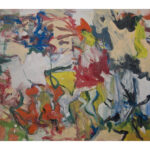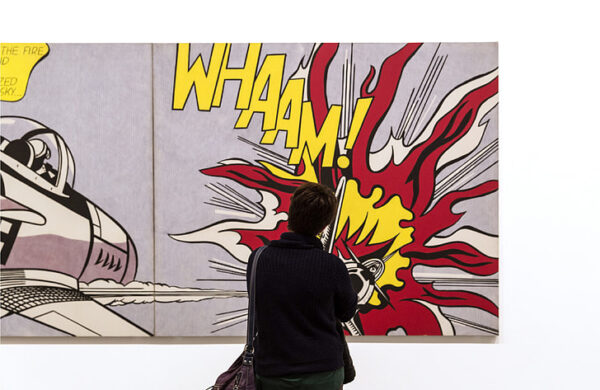Exploring the Evolution of Contemporary Art Movements
As a fervent observer of the art world, I’ve witnessed the fascinating evolution of contemporary art, which epitomizes the art of our time, reflecting the pulse of our ever-changing cultural landscape. This dynamic form encompasses the innovative practices that extend up to the present day, descending from modern art—a movement that revolutionized artistic expression from the late 19th century. My exploration into the world of abstract art, with its rich palette of non-representational forms, reveals a tale of how art has transcended traditional methodologies to mirror the societal changes and technological advancements that define our era.
The transformation from modern to contemporary art is more than a shift in time; it is a continuing redefinition of creativity that challenges the boundaries of what art can convey. This journey through the evolution of art showcases how the bedrock established by modern art has laid the foundations for the intellectual and aesthetic diversity that now thrives within contemporary circles.
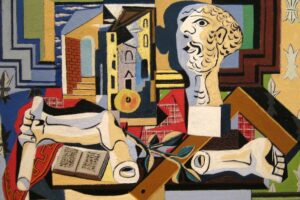 Pablo Picasso’s Studio with Plaster Head – Wally Gobetz ( example of modern art )
Pablo Picasso’s Studio with Plaster Head – Wally Gobetz ( example of modern art )
Key Takeaways
- Contemporary art signifies the current state of the art world, fluidly adapting to new cultural tides.
- Modern art set the stage for abstractive exploration, fundamentally altering traditional art perceptions.
- The evolution of art is a reflection of society’s metamorphosis over time.
- Abstract art introduced a language of form and color that communicates beyond the representational.
- The variety of contemporary art movements is a testament to the assorted expressions within the art community.
Understanding Modern vs. Contemporary Art
As I delve into the intricate web of art history, it’s essential to distinguish between modern and contemporary art—a task often complicated by overlapping characteristics and the fluidity of art movements’ timelines. Let’s explore the distinctive yet interrelated spheres of these pivotal artistic periods.
Brief Overview of Modern Art
 The Persistence of Memory (1931) by Salvador Dali – Mike Steele – example of modern art
The Persistence of Memory (1931) by Salvador Dali – Mike Steele – example of modern art
The germ of artistic innovation sprouted in the late 19th century with modern art challenging the academies and their stringent norms. Embracing abstraction, it heralded a new freedom for the artist’s vision, encapsulated in movements that carved the bedrock of modernism. Artists like Pablo Picasso and Wassily Kandinsky and Salvador Dali were instrumental in dawning this era of expressive liberty, most notably through Cubism and Surrealism—movements that continue to echo through the corridors of art history.
Defining Contemporary Art and Its Scope
Post-war period reflections in the arts birthed contemporary art, gaining momentum from the 1960s onwards. It’s an expansive field, weaving together a myriad of practices. From installation art to digital media, contemporary art refuses to sit still, characterized by its response to the now, an art movement in constant flux—a mirror to societal changes and technological leaps.
The Blurred Lines Between Both Movements
The transition from modern to contemporary often appears seamlessly blurred, like a painter’s brushstroke that blends two hues on a canvas. Where modern art left questions about form and function, contemporary art continues the conversation, pushing the idea of what art is, and what it could be, into ever-evolving boundaries influenced by today’s global reality.
Understanding these art movements sheds light on a vibrant timeline of human expression, showcasing an unwavering spirit of innovation from the late 19th century through the post-war period and beyond.
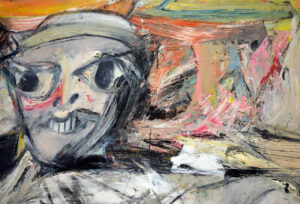 Willem De Kooning, Woman I, 1950-52 (detail)
Willem De Kooning, Woman I, 1950-52 (detail)
| Period | Characteristics | Notable Movements | Key Figures |
|---|---|---|---|
| Late 19th Century | Breakaway from academic traditions, burgeoning abstraction | Cubism, Surrealism | Pablo Picasso, Wassily Kandinsky |
| Post-war to 1960s | Reflection on societal shifts, advent of mixed media | Abstract Expressionism, Pop Art | Jackson Pollock, Andy Warhol |
| 1970s to Present | Media diversity, digital integration, interactive formats | Installation Art, Digital Art | Anish Kapoor, Cindy Sherman |
The Pioneers Shaping Modern Art
The lineage of modern art is largely entwined with the profound shifts in technology and thought that emerged during the Industrial Revolution. This era’s advancements set the stage for modern artists to rethink traditional aesthetics and create bold, expressive works that would eventually bridge into movements such as Cubism, Surrealism, and Abstract Expressionism. As I delve into the nuances of these art forms, it’s clear that the rules of tradition were not so much broken as they were rewritten by the pioneers of this vibrant epoch.
Catalysts for Modern Art’s Advent
The locomotive force of the Industrial Revolution propelled society into an era of unforeseen possibilities. It was this backdrop of industrial change and social upheaval that gave impetus to a burgeoning group of forward-thinking artists. They saw the world anew, and with this vision came an irrepressible desire to capture the zeitgeist in forms and colors never before seen on canvas.
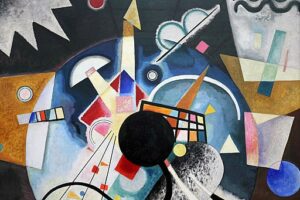 Wassily kandinsky, un centro, 1924
Wassily kandinsky, un centro, 1924
Dissecting Key Characteristics of Modern Art
In the hands of the modernists, art was no longer a mere reflection of reality, but a complex tapestry of perspectives, emotions, and theoretical constructs. The abstraction and fragmentation inherent in Cubism, the dreamlike tapestries of Surrealism, and the raw emotional impact of Abstract Expressionism all share a commonality in their break from traditional representation. Instead, these movements reveled in experimentation, daringly exploring the inner workings of the human psyche and the subtleties of the visual experience.
Influential Figures: Picasso to Pollock
Among the giants who crafted the anatomy of modern art, names such as Pablo Picasso and Jackson Pollock loom large. Picasso, a maestro of Cubism, orchestrated a visual revolution with his radical approach to form and perspective. Following the trajectory, Pollock splattered and dripped his way to artistic notoriety, giving Abstract Expressionism a whole new rhythm and intensity. It was these artists’ unyielding passion to explore and articulate the human condition that consistently pushed the boundaries of artistic expression.
| Movement | Artists | Innovations | Impact on Contemporary Art |
|---|---|---|---|
| Cubism | Pablo Picasso, Georges Braque | Fragmentation of objects, use of multiple perspectives | Inspired new forms of visual storytelling |
| Surrealism | Salvador Dalí, René Magritte | Exploring the unconscious, dream-like imagery | Expanded the scope of art to encompass the realm of dreams and imagination |
| Abstract Expressionism | Jackson Pollock, Mark Rothko | Spontaneity, emotional intensity, scale | Paved the way for personal expression in art and influenced later performance art |
The tendrils of influence from these pivotal movements continue to infiltrate the canvas of contemporary art, much like the afterglow of a setting sun that refuses to be forgotten. While my journey through the epochs of art history is far from over, the trailblazers of modernism have left indelible marks on the landscape of human creativity—a testament to their unparalleled vision and daring.
The Innovation and Influence of Abstract Art
When I reflect upon the course of abstract art, its emergence seems almost like a destined revolution. The inherent freedom of artistic expression embodied by abstraction has transformed our understanding of visuals and opened new horizons of creativity. For me, the allure lies in the very essence of innovative techniques, which turn the canvas into a dynamic symphony of shapes and colors.
The modern art influence is undeniable—movements led by trailblazers such as Wassily Kandinsky have not only challenged our perception of art but also reshaped it. To witness only the surface of a piece is to miss the spiritual dialogue conveyed through the abstract medium. It is the solemn dance of pigment and form that whispers the deeper truths of human experience, often in ways that words cannot express.
Abstraction is not merely an artistic choice; it is a bold statement of individuality, a declaration that art need not imitate life directly but can itself be a life force, pulsing with its own rhythm and reason. As an artist, adopting these innovative techniques becomes more than practice, it becomes a pilgrimage to the core of one’s own creative spirit—a spirit that continues to mold the boundless landscape of contemporary art.
The true value of art is measured by the ability to evoke emotion and provoke thought, to resonate with the beholder in a manner that transcends temporal and spatial constraints.”
- Exploration of non-representational forms
- Emphasis on structural elements such as line, color, and texture
- Utilizing art to express intangible concepts and emotions
In my engagement with abstract art, I hold steadfast to the belief that its intellectual and emotional potency is a testament to the enduring influence of modern art. As abstract art continues to flourish, its dialect grows richer, inspiring contemporary artists to chart new territories of expression and innovation.
Contemporary Art’s Response to Social Change
The landscape of contemporary art is perpetually shifting, serving as both a mirror and a mold through which we view and shape our societal progress. It is through this artistic lens that we engage with social commentary, challenging the status quo and sparking vital conversations. In my experience analyzing art trends, I’ve observed that contemporary art’s dynamic spirit thrives on the pulse of current events, illustrating a multi-faceted reflection on society. Below, we’ll dissect how technology has infused new life into the art scene, paving the way for innovative forms of expression.
The Reflexive Nature of Contemporary Art
As a witness to the transformative power of contemporary art, I’ve come to recognize its reflective quality. It is a responsive medium, almost sentient in its ability to absorb and project the emotional, political, and social currents that permeate our daily lives. This reflexive nature is not static but thrives on the ever-evolving human experience, offering candid snapshots of our societal evolution.
Impact of Technology and Digital Media
When we delve into the intersection of technology in art, we navigate a digital renaissance. Artists now incorporate technology to create experiences that are tactile, immersive, and often interactive—extending the reach of their work to audiences globally. Digital media heralds a new era, breaking boundaries between the artist, the artwork, and the viewer.
| Technological Advancement | Influence on Contemporary Art |
|---|---|
| Internet and Social Media | Socially engaged art projects amplified by digital platforms for greater outreach |
| Augmented Reality (AR) | Interactive installations that merge physical and virtual worlds |
| 3D Printing | Creation of complex, multi-dimensional artworks personalizable for viewer interaction |
| Artificial Intelligence (AI) | AI-generated pieces that raise questions about creativity and machine involvement |
In my analysis, the table above captures just a snapshot of how art has been revolutionized by technology, challenging traditional modes of creation and reception. As a journalist and art enthusiast, I applaud the adaptability of contemporary artists as they embrace these tools—redefining what it means to make art, while broadcasting powerful social narratives. In essence, contemporary art’s dynamic is intricately tied to its ability to evolve and re-contextualize itself amidst our technologically charged world—a testament to its relevance and resilience.
The Evolutionary Path of Contemporary Art Movements
As I delve deeper into the progression of artistic expression, I am struck by the emergence of art trends that defy traditional classification, signifying a seismic shift heralded by postmodernism in art. The incorporation of new art forms and the advent of installation art reflect a dynamic landscape where the boundaries of creativity are continually redrawn. It is an era underscored by the rapid proliferation of diverse artistic methods, challenging the art connoisseur and casual observer alike to redefine what they consider to be true ‘art’.
Proliferation of New Art Forms
The seeds sown by modernism have blossomed into a vast field of new art forms, each rooted in a desire to communicate more authentically with the audience. Installation art, in particular, offers an immersive experience that goes beyond visual contemplation, engaging multiple senses and sometimes inviting direct interaction from its audience. This form leverages space and context, creating environments that transcend the traditional canvas and gallery wall.
Postmodernism’s Contribution to the Contemporary
Postmodernism has skillfully woven its narrative into the tapestry of contemporary art. It stands as a bold critic and innovator, pushing back against the constraints of established conventions and heralding a multifaceted approach to meaning and interpretation. Postmodernism encourages dialogue, asking both artist and viewer to question the underlying assumptions that govern their perceptions of the world around them.
Tracing the Roots and Rise of Contemporary Art
As I delve into the origins of contemporary art, it becomes apparent that a significant transformation took place in the aftermath of World War II—a period that served as a catalyst, altering the trajectory of art history. The mid-20th century art scene was marked by a discernible shift away from traditional artistic norms, driven by a generation of artists who were eager to redefine the essence of art in the post-World War II period.
The Shift from Traditional to Contemporary Practices
The movement away from conventional aesthetics and approaches in the arts was not sudden. It evolved out of a necessity to express the new realities of a world recovering from war’s devastation and the desire to reflect an ever-modernizing society. Artists began questioning and ultimately transgressing the boundaries established by traditional artistic norms, which had long dominated the arts. What emerged was a new paradigm that embraced the abstract, the conceptual, and the non-representational—elements that have become synonymous with contemporary artistic expression.
The Emergence of Contemporary Art Post-World War II
The post-World War II period was pivotal in unveiling a newfound freedom that artists exploited to produce works resonating with the era’s collective consciousness. Self-expression and societal critique became fundamental to the creative process, signaling the birth of contemporary art. This momentum of innovation propelled artists to experiment with new mediums, techniques, and concepts, thus laying the groundwork for the diverse art forms we see today.
The interchange between the old and the new during this transitional era was not only a result of changing tastes but a necessary evolution influenced by the rapid changes in society, technology, and global connections.
| Period | Art Movements | Influences | Characteristics |
|---|---|---|---|
| Post-WWII (1945-1960s) | Abstract Expressionism, Pop Art | Societal Changes, Technological Advancements | Spontaneity, Dramatic Colors, Non-representational Imagery |
| Mid-20th Century | Minimalism, Conceptual Art | Anti-war Sentiments, Cultural Shifts | Geometric Abstraction, Intellectualism, Interactivity |
| Late 20th Century to Present | Performance Art, Digital Media Art | Globalization, Digital Revolution | Interdisciplinary Approaches, Virtual Engagement, Social Commentary |
As an art enthusiast, I am compelled to recognize that the forms and practices within contemporary art that we explore and celebrate today are deeply rooted in the efforts of those post-World War II artists who dared to look beyond traditional artistic norms. Their legacy has provided a versatile platform from which modern-day artists continue to push boundaries and challenge perceptions, proving that art is not static but an ever-evolving dialogue with time.
Milestones in Contemporary Art Movements: A Timeline
Examining the rich tapestry that delineates the progression from 20th century art to 21st century art, I am drawn to the defining moments and prominent art movements that have punctuated the art timeline. Notably, the following milestones signify the growth and transformations that have led to the current state of contemporary art, making it an eclectic and vibrant field.
| Decade | Movements | Key Characteristics |
|---|---|---|
| 1960s | Pop Art, Minimalism | Focus on mass culture and simplicity |
| 1970s | Conceptual Art, Performance Art | Emphasis on ideas and live artistry |
| 1980s | Neo-Expressionism | Revival of painting with emotional intensity |
| 1990s | Young British Artists (YBAs), Installation Art | Shock tactics and immersive environments |
| 2000s | Digital Art, Street Art | Integration of technology and urban canvas |
| 2010s – Present | Virtual Reality Art, Social Practice Art | Use of VR technology and art as social commentary |
The transition from 20th century art, which included groundbreaking movements like Abstract Expressionism, to the diverse practices of 21st century art, reveals a pattern of adaptation and reflection of contemporary society’s sentiments. The prominent art movements of our time no longer fit neatly into singular categories, but rather coalesce to form a fluid and interconnected art timeline.
Contemporary art is constantly evolving, breaking new ground, and redefining the way we perceive and interact with the visual language around us.
To truly understand the spectrum of contemporary art, one must consider the external forces that have shaped its trajectory – from political upheaval and social revolutions to leaps in digital technology and global interconnectedness. The present day offers a unique vantage point from which we can appreciate the multidimensional layers that constitute the living history of art.
Contemporary Art and Its Major Contributors
As an enthusiast delving into the intricacies of the art world, I find it essential to acknowledge the influential spaces that foster contemporary art’s growth. Notably, art galleries and art museums offer transformative platforms for dynamic expression and dialogue.
The Role of Art Galleries and Museums in Shaping Movements
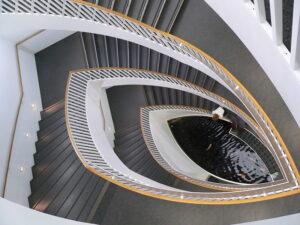 Staircase at Chicago’s Museum of Contemporary Art
Staircase at Chicago’s Museum of Contemporary Art
In the pulsating heart of the art market, it is the galleries and museums that imbue emerging artists with a voice and shape the zeitgeist of our times. From avant-garde art exhibitions to the hallowed halls echoing with art history, these institutions are more than mere venues; they are incubators for talent and innovation.
Exploring the Impact of Iconic Contemporary Artists
Iconic figures in contemporary art are not simply creators; they are pioneers who redefine sensibilities and provoke new thoughts. Artists like Yayoi Kusama cast a polka-dotted perspective on our reality, while the enigmatic Banksy disrupts the status quo with satirical street art. The legendary Frida Kahlo continues to inspire with her vivid tableau of pain and passion. Each of them has utilized the exposure provided by prominent galleries and museums to challenge and captivate international audiences, demonstrating just how significant these spaces are in the proliferation of contemporary art.
Characteristics and Significance of Contemporary Art in Today’s World
As a copywriting journalist who has observed the shifting landscape of the arts, I’ve seen firsthand how the burgeoning conduits of creativity in contemporary art mirror the intricacies of our current era. It is within this rich framework that artistic movements like mixed media, abstract expressionism, and performance art breathe life into the ideals we hold dear, offering a canvas where reflections of our times become immortalized.
Explaining Contemporary Art’s Diverse Manifestations
In today’s art scene, mixed media serves as a testament to innovation, combining elements like painting, sculpture, and digital interventions to create a multifaceted dialogue with the audience. Abstract expressionism continues to challenge perceptions, harnessing the power of color and form to evoke the deepest of emotions. Meanwhile, performance art breaks the proverbial fourth wall, directly engaging with viewers and often leaving an indelible mark on the social consciousness.
How Contemporary Art Mirrors Current Cultures and Ideals
Our digital age has given birth to an unprecedented form of artistry- digital age art. Marrying technology with traditional practices, artists now curate experiences that resonate across global platforms, eliciting conversations that traverse traditional geographical and cultural barriers. This transformative power of contemporary art not only reflects our world but actively participates in shaping it.
| Art Movement | Mediums Used | Cultural Impact |
|---|---|---|
| Mixed Media | Combination of physical and digital elements | Fosters interdisciplinary dialogue and innovation |
| Abstract Expressionism | Emphasis on spontaneous, automatic, or subconscious creation | Encourages personal interpretation and emotional connection |
| Performance Art | Live presentations with interactive aspects | Cultivates a shared experience and challenges social norms |
| Digital Age Art | Utilizes digital technology as an essential part of the creative process | Democratizes art through accessibility and relatability |
Contemporary art, undeniably, does more than fill galleries; it spurs a dialogue, it propels thought, and most importantly, it continues to redefine itself in the formidable expanse of our evolving cultural tapestry.
Dissecting Critiques and Embracing Contemporary Art’s Eccentricities
The world of art is perpetually under a microscope, with diverse voices scrutinizing its purpose and value. In my experience, modern and contemporary art invite particularly vehement criticism due to their distinct departure from historical methods and messages. But it is within these criticisms that lies a deeper understanding of what these movements aim to accomplish. Let’s delve into the complexities and debates that swirl around modern and contemporary creations.
Examining Common Criticisms of Modern and Contemporary Art
 KAWS at the Modern Museum, Fort Worth
KAWS at the Modern Museum, Fort Worth
Criticisms of modern art often steer towards the notions of elitism and inaccessibility. Detractors argue that modern pieces—splattered canvases reminiscent of Jackson Pollock’s work or the abstract figures resonant of Marc Chagall’s paintings—eschew plain meaning for ambiguous interpretations, which sometimes alienates the general public. Likewise, contemporary art, with its often unconventional mediums and presentations, can perplex and even provoke traditional art enthusiasts. Some claim that these modern manifestations lack the craftsmanship in art long revered in classical forms.
Counterargument for the Form’s Value and Importance
Yet, in my perspective, to equate the value of contemporary art only with its immediate comprehensibility is to overlook the artists’ vision and the intrinsic purpose of their work. Artistic vision is not always meant to be easily deciphered; rather, it is an invitation for dialogue and introspection. The value of contemporary art extends beyond mere aesthetic appeal or technical prowess—it embodies the zeitgeist, the collective consciousness of the era, and has the audaciousness to question and redefine societal norms.
What’s more, the interplay between intention and reception is where contemporary art truly gains momentum. Each viewer might distill a personalized interpretation, thereby creating a unique experiential layer atop the artist’s original sentiment. This testament to the diverse, multi-faceted nature of human perspective only emphasizes the importance of contemporary art’s place in modern society.
To adhere solely to traditional criteria for evaluating art would mean to stifle progress and innovation. These modern movements remind us that the flight of creativity is not tethered to yesterday’s techniques but to the potential of tomorrow’s enlightenment. The craftsmanship in art does not simply reside in time-honored skill but equally in the resonance of a piece with its environment and its capacity to invoke reflection and elicit change.
In conclusion, while critical voices play a crucial role in the discourse surrounding art, it’s essential for us to recognize that the criticisms of modern art and the value of contemporary art are not mutually exclusive. Instead, they form a dynamic conversation that enriches our cultural fabric and propels us towards a more introspective understanding of creativity, both past, and present.
Conclusion
In my journey to understand the intricate web of contemporary art movements, I have seen how the vivid strands of innovation and expression weave together a tapestry that captures the essence of our era. The summary of contemporary art offers more than just a mirror to our world; it presents a barometer for the shifts in our cultural landscape, measuring how deeply our societies have been touched by the hands of change. This art evolution isn’t merely a historical record of stylistic changes but a chronicle of human emotion and thought over time.
Reflecting on the impact on cultural landscape, we acknowledge how much of contemporary art is a dialogue—a conversation between creators, viewers, and the times they live in. From the visionary experiments of modern art to the multifaceted expressions of today’s artists, the spectrum of contemporary art has remarkably shaped the way we interact with and appreciate the world around us. As each movement ebbs and flows, it’s captivating to see how they collectively impact our understanding of aesthetics and the potential of human expression.
The narrative of contemporary art, with its relentless push towards new horizons, challenges me to grasp its depth and provocations. Far from a static exhibit to be glanced and forgotten, the legacy of these movements urges me to remain actively engaged, constantly cultivating an appreciation for the vibrant and unending art evolution that stands as a testament to the resiliency and innovation inherent within the creative human spirit.
FAQ
What defines contemporary art and how does it differ from modern art?
Contemporary art refers to the art of the present and encompasses a wide range of practices, methodologies, and technologies. It’s not confined to a specific style but is characterized by its diverse and pluralistic nature. Modern art, which began in the late 19th century, broke away from traditional styles and embraced new ideas centered around individualism and abstraction. Contemporary art continues this trajectory, frequently responding and reflecting on current social, political, and technological concerns, making it dynamic and ever-changing.
How has abstract art influenced contemporary artistic practices?
Abstract art has been a critical driving force in the evolution of contemporary art. With its focus on color, form, and the non-representational, it has allowed artists to express emotions and concepts not tied to visual reality. This liberation from traditional representation has paved the way for contemporary artists to explore a myriad of new materials and ideas, such as conceptual art, installation art, and digital media, broadening the scope of what art can communicate.
Can you explain the blurred lines between modern and contemporary art movements?
The border between modern and contemporary art is often ambiguous and subject to debate. While modern art typically refers to artistic work from the late 19th century up to the 1960s, contemporary art picks up from there, covering the post-war period to the present day. However, both share a spirit of innovation and a break from tradition that can make certain works challenging to categorize definitively as one or the other.
What roles do art galleries and museums play in the development of contemporary art?
Art galleries and museums are vital in the development, promotion, and preservation of contemporary art. They serve as platforms where new works and artists can be introduced to the public. These institutions often support the professional journey of emerging artists while fostering critical dialogue and enhancing public appreciation and understanding of contemporary art movements.
Who are some of the key influencers in the realm of modern art?
Pioneers such as Pablo Picasso, Wassily Kandinsky, and Jackson Pollock are among the key influencers in modern art. Their groundbreaking works in movements like Cubism, Abstract Expressionism, and Surrealism have not only shaped modern art but continue to resonate within contemporary practices, establishing a legacy of creative innovation and the redefinition of artistic norms.
How does contemporary art reflect our current society and its changes?
Contemporary art acts as a mirror to society, reflecting our cultural, political, economic, and technological landscapes. Artists often engage with current events, providing commentary through their work that can question, critique, or affirm the zeitgeist. From social injustice to environmental issues, contemporary art offers a creative lens to view the pressing topics of our time.
What art forms have emerged within the contemporary art movement?
A diverse array of art forms has emerged within contemporary art, including installation art, video art, performance art, digital art, and conceptual art. These forms often defy traditional categories, incorporating mixed media and interactive elements to engage viewers in novel and profound ways.
What impact did the post-war period have on the emergence of contemporary art?
The post-war period signified a profound societal shift, which inherently affected the art world. The trauma and changes resulting from World War II triggered artists to search for new ways to express the complexities of the human condition and the altered state of the world. This search led to more abstract, conceptual, and experimental art forms, which became the foundation of what we now know as contemporary art.
How is the contemporary art market influenced by trends and emerging artists?
The contemporary art market is heavily influenced by both prevailing trends and the rise of new, innovative artists. Collectors, curators, and critics play crucial roles in spotlighting particular movements and individuals, which can have a significant impact on market demand and valuation. Emerging artists, often introduced through galleries and exhibitions, can bring fresh perspectives that capture the art world’s attention, influencing both aesthetic trends and economic dynamics.
What common critiques are directed towards contemporary art?
Contemporary art often faces critiques related to its perceived esoteric nature, with detractors claiming it can be elitist, inaccessible, or lacking in traditional craftsmanship. The readiness to embrace new media and non-traditional methods, as well as the use of conceptual narratives that require viewers to engage with the underlying meaning, can also elicit mixed reactions from the public and critics alike.
How has technology impacted the contemporary art world?
The rise of digital technologies has significantly impacted the contemporary art world by introducing new tools and platforms for creation, distribution, and engagement. Artists utilize digital techniques to produce artwork that wouldn’t have been possible in earlier eras, while the internet provides a global stage for sharing and selling art, connecting creators with wider and more diverse audiences than ever before.
What counterargument is presented for the value and importance of contemporary art against its critiques?
In response to critiques, proponents of contemporary art argue that its value lies in its ability to push boundaries, offer new perspectives, and engage with viewers in a deeply personal and intellectual manner. Contemporary art’s diverse forms and concepts are seen not as deficiencies, but as strengths that reflect the complexity of the modern world and encourage a multiplicity of interpretations and emotions.
 Trend
Trend
